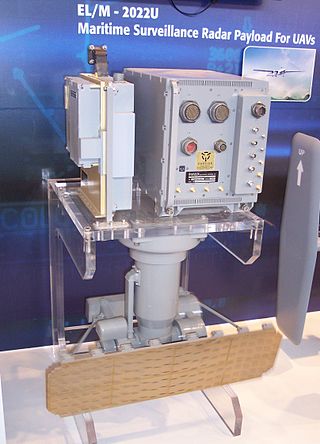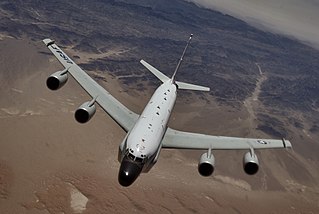Related Research Articles

Signals intelligence (SIGINT) is intelligence-gathering by interception of signals, whether communications between people or from electronic signals not directly used in communication. Signals intelligence is a subset of intelligence collection management. As classified and sensitive information is usually encrypted, signals intelligence in turn involves the use of cryptanalysis to decipher the messages. Traffic analysis—the study of who is signaling whom and in what quantity—is also used to integrate information again.

A superheterodyne receiver, often shortened to superhet, is a type of radio receiver that uses frequency mixing to convert a received signal to a fixed intermediate frequency (IF) which can be more conveniently processed than the original carrier frequency. It was long believed to have been invented by US engineer Edwin Armstrong, but after some controversy the earliest patent for the invention is now credited to French radio engineer and radio manufacturer Lucien Lévy. Virtually all modern radio receivers use the superheterodyne principle.

Electromagnetic compatibility (EMC) is the ability of electrical equipment and systems to function acceptably in their electromagnetic environment, by limiting the unintentional generation, propagation and reception of electromagnetic energy which may cause unwanted effects such as electromagnetic interference (EMI) or even physical damage to operational equipment. The goal of EMC is the correct operation of different equipment in a common electromagnetic environment. It is also the name given to the associated branch of electrical engineering.
Foreign instrumentation signals intelligence, FISINT (Foreign Instrumentation Signature INTelligence) is intelligence from the interception of foreign electromagnetic emissions associated with the testing and operational deployment of foreign aerospace, surface, and subsurface systems. Since it deals with signals that have communicational content, it is a subset of Communications Intelligence (COMINT), which, in turn, is a subset of SIGINT. Unlike general COMINT signals, the content of FISINT signals is not in regular human language, but rather in machine to machine (instrumentation) language or in a combination of regular human language and instrumentation language. FISINT is also considered as a subset of MASINT (measurement and signature intelligence).

A heterodyne is a signal frequency that is created by combining or mixing two other frequencies using a signal processing technique called heterodyning, which was invented by Canadian inventor-engineer Reginald Fessenden. Heterodyning is used to shift signals from one frequency range into another, and is also involved in the processes of modulation and demodulation. The two input frequencies are combined in a nonlinear signal-processing device such as a vacuum tube, transistor, or diode, usually called a mixer.
This is an index of articles relating to electronics and electricity or natural electricity and things that run on electricity and things that use or conduct electricity.

A regenerative circuit is an amplifier circuit that employs positive feedback. Some of the output of the amplifying device is applied back to its input to add to the input signal, increasing the amplification. One example is the Schmitt trigger, but the most common use of the term is in RF amplifiers, and especially regenerative receivers, to greatly increase the gain of a single amplifier stage.
Measurement and signature intelligence (MASINT) is a technical branch of intelligence gathering, which serves to detect, track, identify or describe the distinctive characteristics (signatures) of fixed or dynamic target sources. This often includes radar intelligence, acoustic intelligence, nuclear intelligence, and chemical and biological intelligence. MASINT is defined as scientific and technical intelligence derived from the analysis of data obtained from sensing instruments for the purpose of identifying any distinctive features associated with the source, emitter or sender, to facilitate the latter's measurement and identification.

Electromagnetic interference (EMI), also called radio-frequency interference (RFI) when in the radio frequency spectrum, is a disturbance generated by an external source that affects an electrical circuit by electromagnetic induction, electrostatic coupling, or conduction. The disturbance may degrade the performance of the circuit or even stop it from functioning. In the case of a data path, these effects can range from an increase in error rate to a total loss of the data. Both man-made and natural sources generate changing electrical currents and voltages that can cause EMI: ignition systems, cellular network of mobile phones, lightning, solar flares, and auroras. EMI frequently affects AM radios. It can also affect mobile phones, FM radios, and televisions, as well as observations for radio astronomy and atmospheric science.

ELTA Systems Ltd (ELTA) is an Israeli provider of defense products and services specializing in radar, ELINT, COMINT, C4ISTAR, Electronic Warfare, Communication, Autonomous Ground Systems, Intelligence and Cyber products.
Radio-frequency (RF) engineering is a subset of electronic engineering involving the application of transmission line, waveguide, antenna and electromagnetic field principles to the design and application of devices that produce or use signals within the radio band, the frequency range of about 20 kHz up to 300 GHz.
National technical means of verification (NTM) are monitoring techniques, such as satellite photography, used to verify adherence to international treaties. The phrase first appeared, but was not detailed, in the Strategic Arms Limitation Treaty (SALT) between the US and USSR. At first, the phrase reflected a concern that the "Soviet Union could be particularly disturbed by public recognition of this capability [satellite photography]...which it has veiled.". In modern usage, the term covers a variety of monitoring technologies, including others used at the time of SALT I.
Materials MASINT is one of the six major disciplines generally accepted to make up the field of Measurement and Signature Intelligence (MASINT), with due regard that the MASINT subdisciplines may overlap, and MASINT, in turn, is complementary to more traditional intelligence collection and analysis disciplines such as SIGINT and IMINT. MASINT encompasses intelligence gathering activities that bring together disparate elements that do not fit within the definitions of Signals Intelligence (SIGINT), Imagery Intelligence (IMINT), or Human Intelligence (HUMINT).
Nuclear MASINT is one of the six major subdisciplines generally accepted to make up Measurement and Signature Intelligence (MASINT), which covers measurement and characterization of information derived from nuclear radiation and other physical phenomena associated with nuclear weapons, reactors, processes, materials, devices, and facilities. Nuclear monitoring can be done remotely or during onsite inspections of nuclear facilities. Data exploitation results in characterization of nuclear weapons, reactors, and materials. A number of systems detect and monitor the world for nuclear explosions, as well as nuclear materials production.
Radar MASINT is a subdiscipline of measurement and signature intelligence (MASINT) and refers to intelligence gathering activities that bring together disparate elements that do not fit within the definitions of signals intelligence (SIGINT), imagery intelligence (IMINT), or human intelligence (HUMINT).
Electro-optical MASINT is a subdiscipline of Measurement and Signature Intelligence, (MASINT) and refers to intelligence gathering activities which bring together disparate elements that do not fit within the definitions of Signals Intelligence (SIGINT), Imagery Intelligence (IMINT), or Human Intelligence (HUMINT).
Geophysical MASINT is a branch of Measurement and Signature Intelligence (MASINT) that involves phenomena transmitted through the earth and manmade structures including emitted or reflected sounds, pressure waves, vibrations, and magnetic field or ionosphere disturbances.

Signals intelligence operational platforms are employed by nations to collect signals intelligence, which is intelligence-gathering by interception of signals, whether between people or between machines, or mixtures of the two. As sensitive information is often encrypted, signals intelligence often involves the use of cryptanalysis. However, traffic analysis—the study of who is signalling whom and in what quantity—can often produce valuable information, even when the messages themselves cannot be decrypted.
After the end of World War II, all the Western allies began a rapid drawdown of military forces, including those of signals intelligence. At the time, the US still had a COMINT organization split between the Army and Navy. A 1946 plan listed Russia, China, and a [redacted] country as high-priority targets.
References
- ↑ Interagency OPSEC Support Staff (IOSS) (May 1996). "Operations Security Intelligence Threat Handbook: Section 2, Intelligence Collection Activities and Disciplines". IOSS Section 2. Archived from the original on 2019-05-04. Retrieved 2007-10-03.
- 1 2 Center for MASINT Studies and Research. "Center for MASINT Studies and Research". Air Force Institute of Technology. CMSR. Archived from the original on 2007-07-07. Retrieved 2007-10-03.
- 1 2 US Army (May 2004). "Chapter 9: Measurement and Signals Intelligence". Field Manual 2-0, Intelligence. Department of the Army. Archived from the original on 2007-07-26. Retrieved 2007-10-03.
- ↑ Wright, Peter; Paul Greengrass (1987). Spycatcher: The Candid Autobiography of a Senior Intelligence Officer. Penguin Viking. ISBN 0-670-82055-5. Wright 1997.
- ↑ Strategic Air Command. "SAC Reconnaissance History January 1968-June 1971" (PDF). SAC 1971. Archived (PDF) from the original on 2014-06-17. Retrieved 2007-10-12.
- ↑ Kopp, Carlo (1996). "The Electromagnetic Bomb - a Weapon of Electrical Mass Destruction". Globalsecurity.org. Kopp 1996. Archived from the original on 2007-10-11. Retrieved 2007-10-15.
- ↑ Correll, John T. (November 2004). "Igloo White". Air Force Magazine Online. 87 (11). Igloo White (text only). Archived from the original on 30 September 2007. Retrieved 31 July 2013.
- ↑ Atkinson, James M. (2002). "Video Signal Eavesdropping Threat Tutorial". Atkinson Video. Archived from the original on 2007-10-12. Retrieved 2007-10-16.
- ↑ Atkinson, James M. (2002). "Spectral Analysis of Various RF Bugging Devices". Atkinson RF Spectra. Archived from the original on 2007-11-02. Retrieved 2007-10-16.
- 1 2 3 "Tempest Timeline". 23 January 2002. Archived from the original on 11 February 2008. Retrieved 6 February 2008.